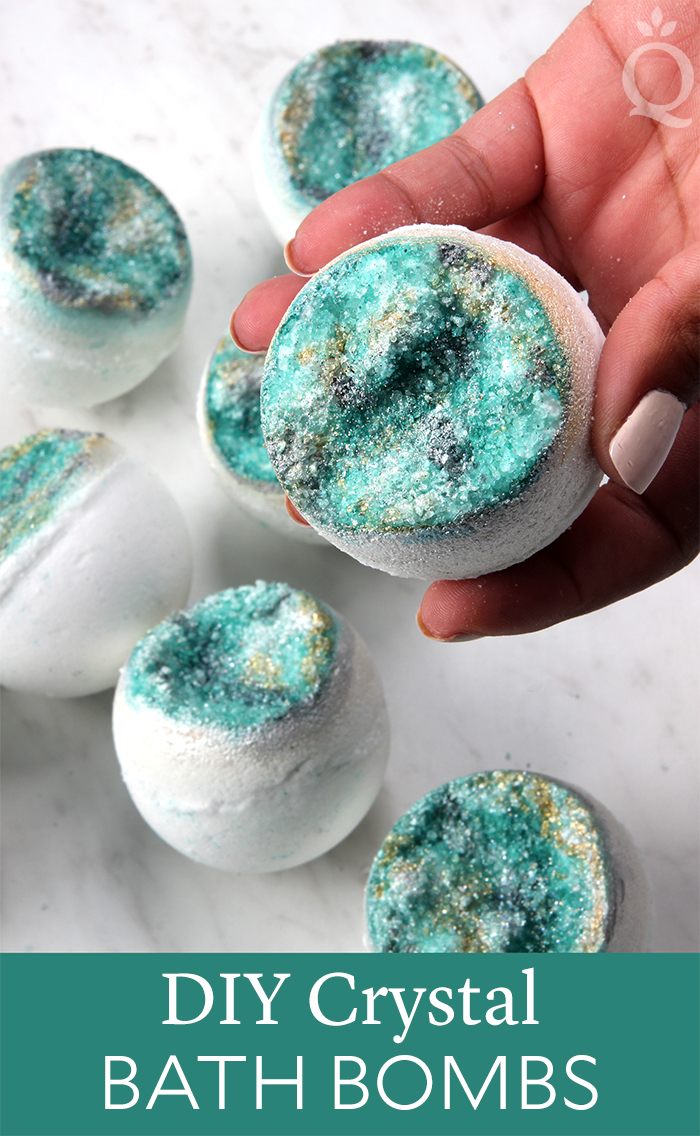
The colors and textures of crystals provide endless inspiration. These Crystal Bath Bombs were created with geodes in mind. Fine grained Dead Sea Salt gives a crystal-like texture to each bath bomb. Then, various colors of mica are painted on the salt to give depth and interest.
Deodorized cocoa butter is added to the bath bomb mixture for structure and skin-loving properties. If you don’t have deodorized cocoa butter, regular cocoa butter will work as well. New Jade Fragrance Oil gives these bath bombs a sweet floral scent that’s perfect for the green color palette.
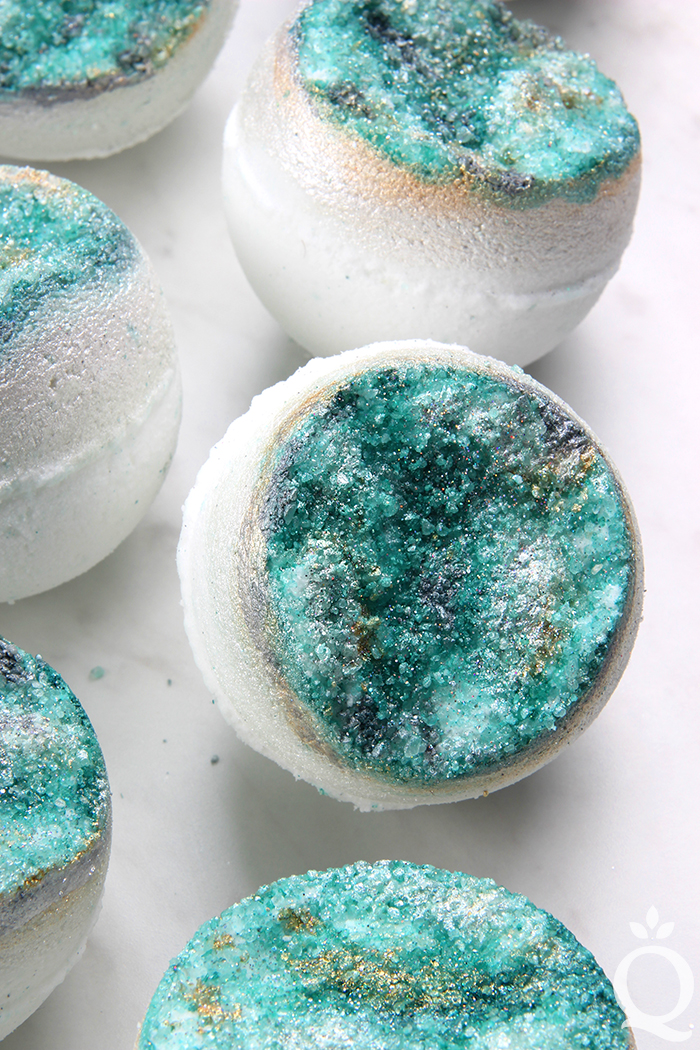
Because these bath bombs have plenty of oil and mica, polysorbate 80 is used. Polysorbate 80 is an emulsifier that helps the cocoa butter disperse more evenly in the bath water rather than pooling on top. It also prevents the mica from clinging to the side of the tub. We found a minimal amount of color on the tub after using these bath bombs. But because mica likes to cling to residue, give your tub a quick wipe down before use.
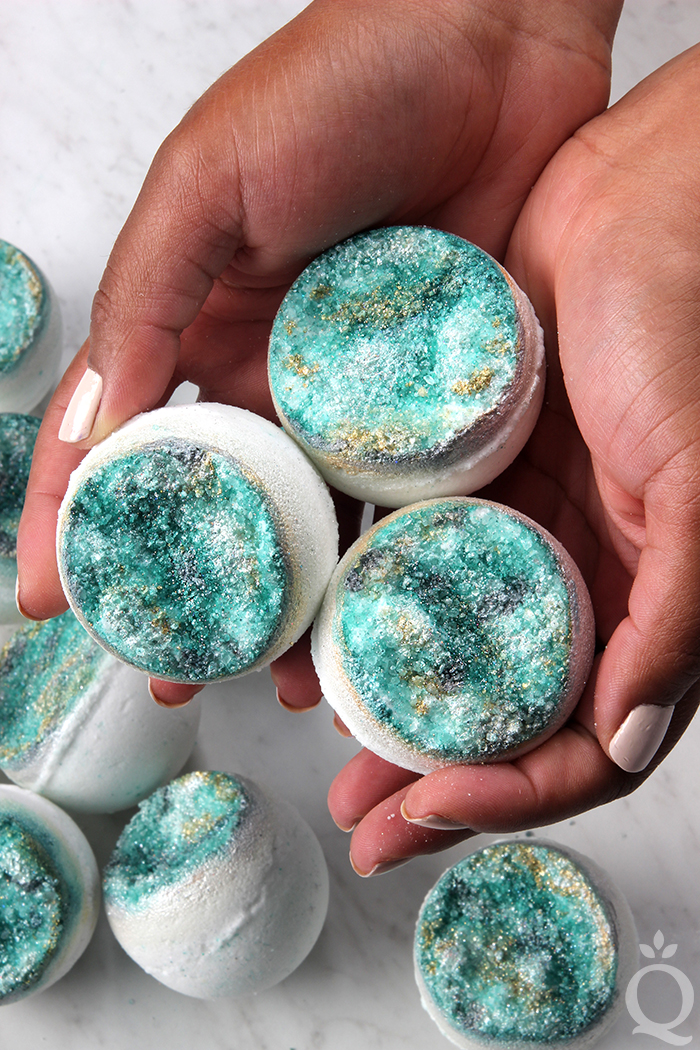
This project requires some fine detail paint brushes. Painting the bath bombs does take a little practice, but don’t worry about the design being too perfect – have fun with it. As a finishing touch, Fine Silver Rainbow EcoGlitter is sprayed on top using the new Powder Sprayer. The glitter really gives each bath bomb the perfect sparkly touch.
What You Need:
10 Bath Bomb Mold & Package
26 oz. Sodium Bicarbonate (Baking Soda)
13 oz. Citric Acid
Witch Hazel in a Spray Bottle
0.7 oz. Jade Fragrance Oil
3 oz. Deodorized Cocoa Butter
0.6 oz. Polysorbate 80
6 oz. Fine Grained Dead Sea Salt
Shamrock Green Mica
Super Pearly White Mica
Gold Sparkle Mica
Pewter Silver Mica
1/2 tsp. Fine Silver Rainbow EcoGlitter
Powder Sprayer (filled with Fine Silver Rainbow EcoGlitter)

Click here to add everything you need for this project to your Bramble Berry shopping cart!
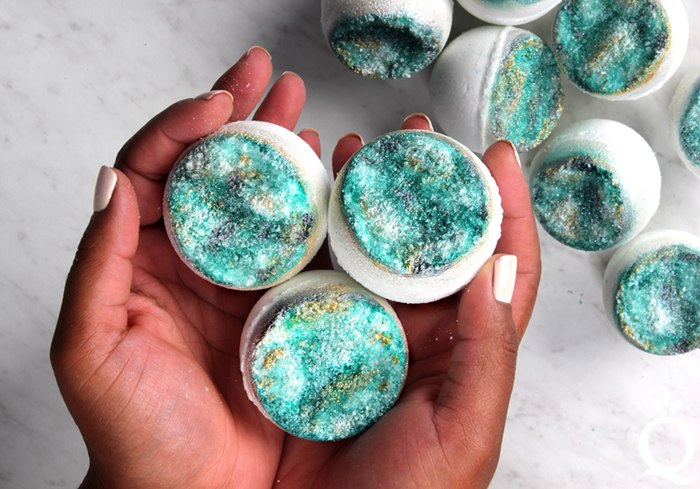
ONE: Melt the cocoa butter in a small heat-safe container in the microwave using 30-60 second bursts. Because cocoa butter has a high melting point, be very careful when removing the container from the microwave – it will be very hot.
TWO: Add the polysorbate 80 and Jade Fragrance Oil to the melted cocoa butter. Stir to mix all the ingredients together.
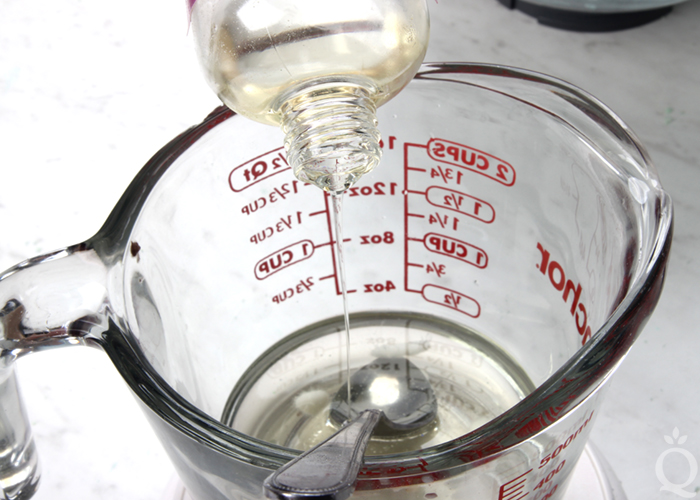
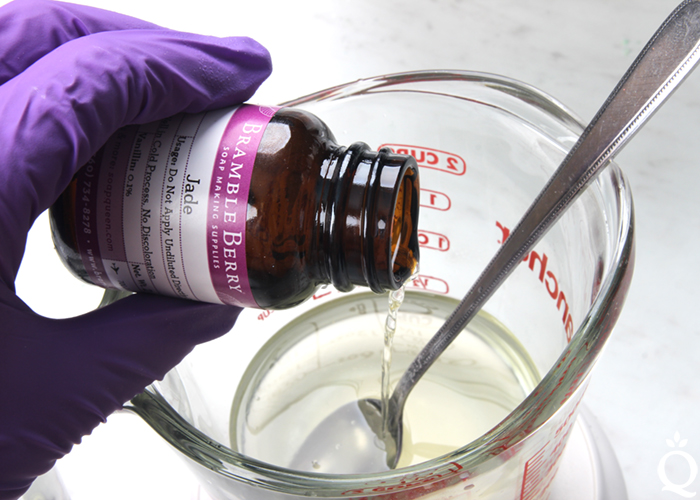 THREE: In a separate large container, mix together the baking soda and citric acid. To get rid of clumps in the mixture, you can push the powder through a sifter or break them up with your fingers. Citric acid has a tendency to take off nail polish, so wear gloves to protect your manicure. Thoroughly stir the ingredients together.
THREE: In a separate large container, mix together the baking soda and citric acid. To get rid of clumps in the mixture, you can push the powder through a sifter or break them up with your fingers. Citric acid has a tendency to take off nail polish, so wear gloves to protect your manicure. Thoroughly stir the ingredients together.
FOUR: Add the oil mixture to the baking soda and citric acid. Use gloved hands to thoroughly mix all the ingredients together. Set aside.
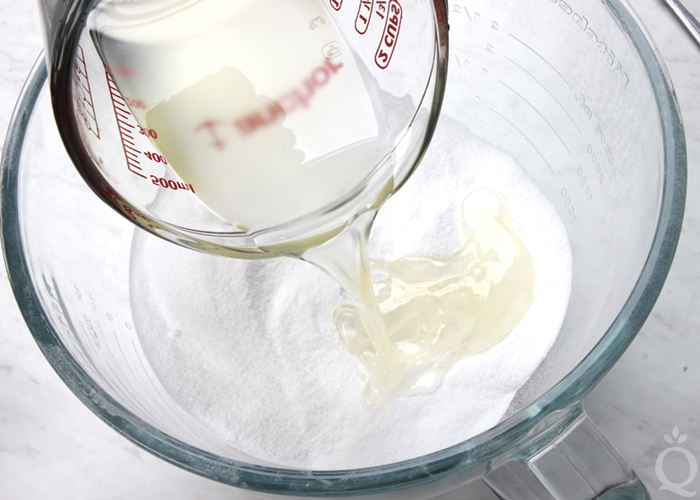 FIVE: In a separate bowl, add the fine grained Dead Sea salt, 1/2 tsp. Fine Silver Rainbow EcoGlitter, and 1/4 tsp. Shamrock Green Mica. Use a spoon to mix all the ingredients together.
FIVE: In a separate bowl, add the fine grained Dead Sea salt, 1/2 tsp. Fine Silver Rainbow EcoGlitter, and 1/4 tsp. Shamrock Green Mica. Use a spoon to mix all the ingredients together.
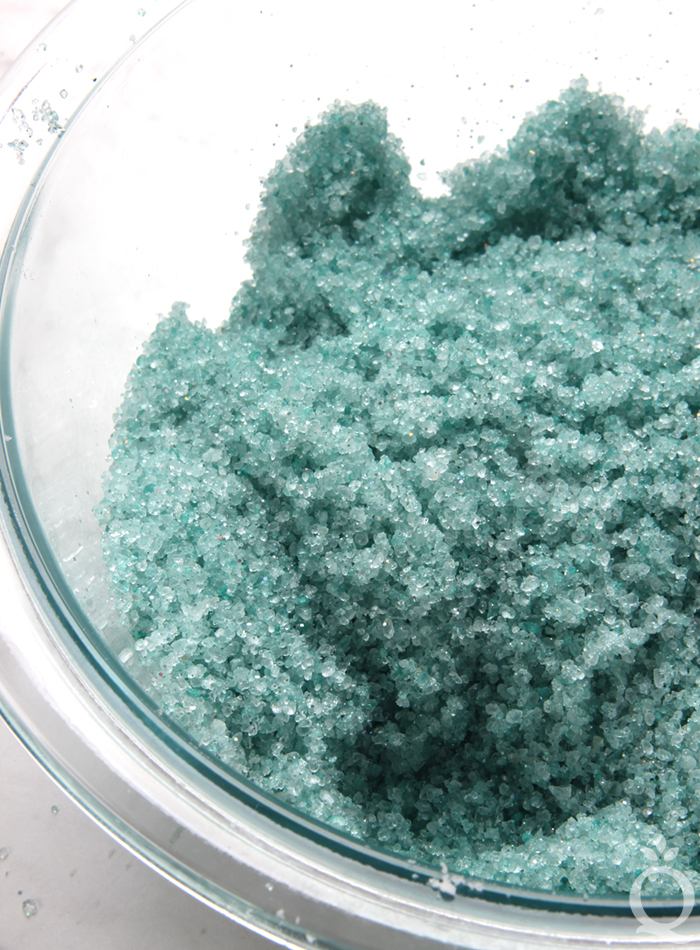 SIX: Place some green salt into one half of the bath bomb mold. It should fill the mold about 1/3 of the way. Keep in mind that once the bath bomb is umolded, the salt will be dusted off the bath bomb to give the crystal shape. Don’t be afraid to use a deep layer of salt.
SIX: Place some green salt into one half of the bath bomb mold. It should fill the mold about 1/3 of the way. Keep in mind that once the bath bomb is umolded, the salt will be dusted off the bath bomb to give the crystal shape. Don’t be afraid to use a deep layer of salt.
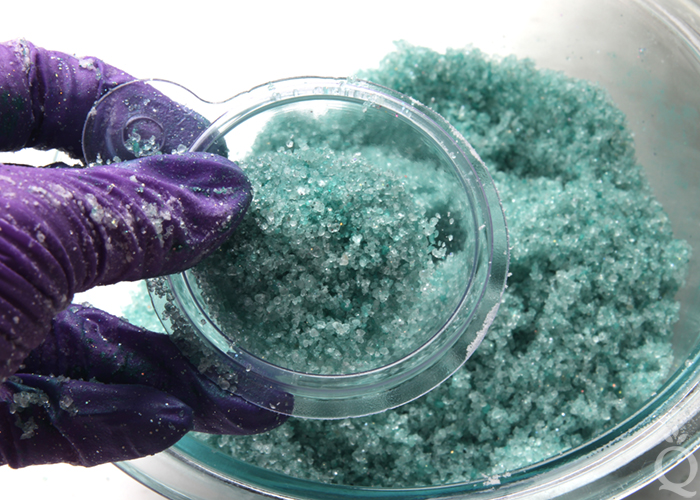 SEVEN: Test the consistency of the bath bomb mixture. The perfect consistency for molding is similar to wet sand and holds its shape when squeezed. If it’s too dry, use one hand to spritz the mixture with witch hazel and one to mix. Continue spritzing until the mixture holds its shape when squeezed. Cover the salt with bath bomb mixture. Gently pack the bath bomb mixture into the mold, but leave some loose mixture on top.
SEVEN: Test the consistency of the bath bomb mixture. The perfect consistency for molding is similar to wet sand and holds its shape when squeezed. If it’s too dry, use one hand to spritz the mixture with witch hazel and one to mix. Continue spritzing until the mixture holds its shape when squeezed. Cover the salt with bath bomb mixture. Gently pack the bath bomb mixture into the mold, but leave some loose mixture on top.
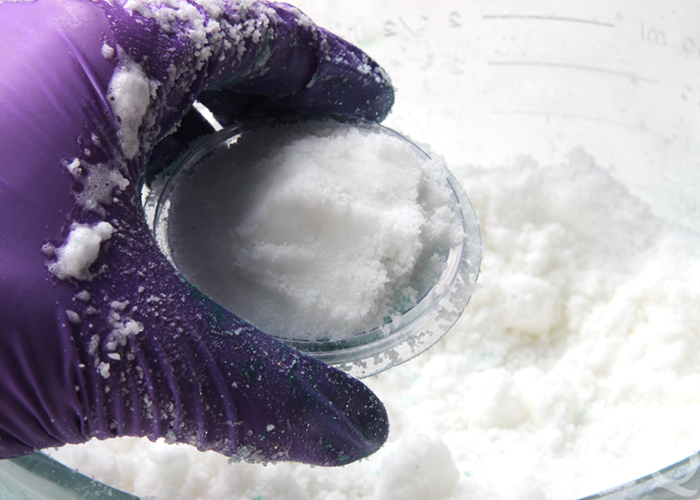 EIGHT: Fill the other half of the bath bomb mold with mixture, packing in gently and leaving some loose mixture on the top. Overfilling each half slightly with loose mixture helps the two halves stick together. Wipe away any mixture that got in the seams of the mold, match the eyelets of each side up, and press together. To avoid any imperfections on your bath bomb, make sure to direct pressure to the edges of the mold rather than the center.
EIGHT: Fill the other half of the bath bomb mold with mixture, packing in gently and leaving some loose mixture on the top. Overfilling each half slightly with loose mixture helps the two halves stick together. Wipe away any mixture that got in the seams of the mold, match the eyelets of each side up, and press together. To avoid any imperfections on your bath bomb, make sure to direct pressure to the edges of the mold rather than the center.
NINE: Continue filling up each bath bomb with the salt mixture and bath bomb mixture. Once the molds are all filled, allow the bath bombs to dry and harden in the molds. For the best results, we recommend leaving the bath bombs in the mold overnight. The longer they dry, the more durable they will be.
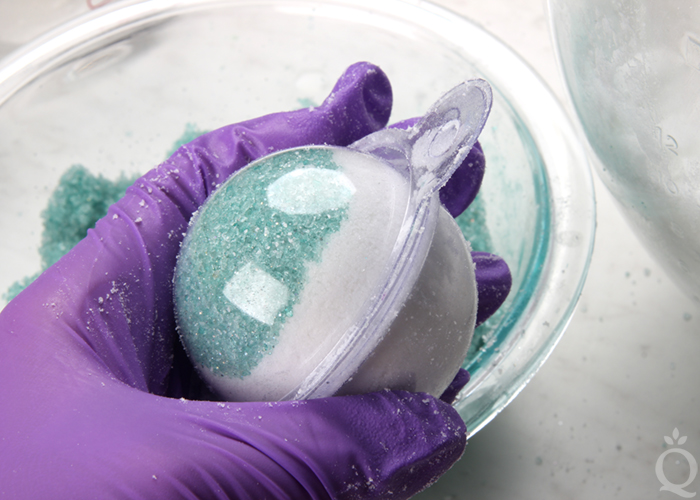 TEN: Remove the bath bombs from the mold by pulling on both eyelets. Once unmolded, use your finger to gently brush away the extra salt. You’ll be left with a bath bomb with an indent.
TEN: Remove the bath bombs from the mold by pulling on both eyelets. Once unmolded, use your finger to gently brush away the extra salt. You’ll be left with a bath bomb with an indent.
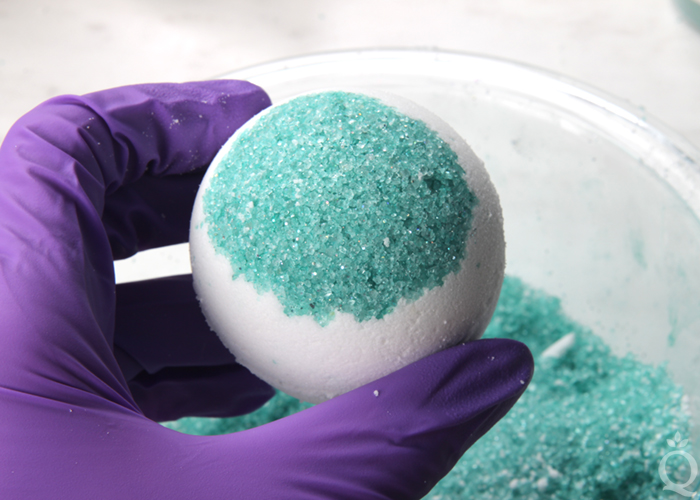
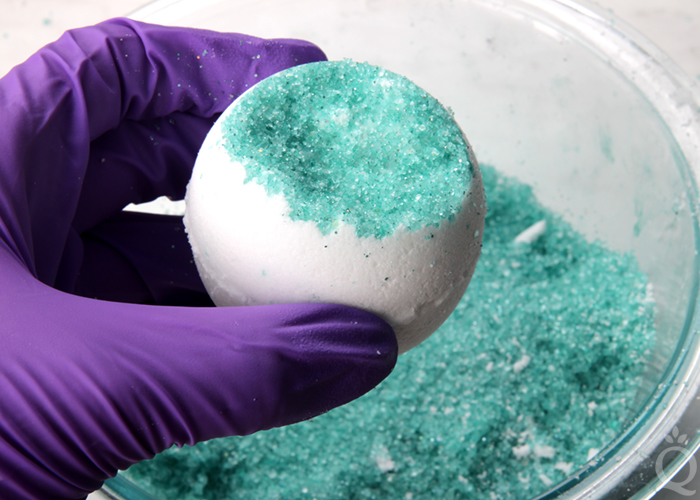 ELEVEN: Remove all the bath bombs from the mold and remove the excess salt. If you like, you can save the salt for future projects. In separate containers, mix together 1/2 tsp. of Super Pearly White Mica, Shamrock Green Mica, Gold Sparkle Mica, and Pewter Silver Mica into about 1/2 Tbsp. of 99% isopropyl alcohol. The mica mixture should be thin but still saturated. As you paint, you’ll find your preference of mica paint texture. Add more mica or alcohol according to your preference throughout the painting process. Fill a small container with alcohol to rinse your brush and blend colors. Finally, fill the Powder Sprayer with Fine Silver Rainbow EcoGlitter.
ELEVEN: Remove all the bath bombs from the mold and remove the excess salt. If you like, you can save the salt for future projects. In separate containers, mix together 1/2 tsp. of Super Pearly White Mica, Shamrock Green Mica, Gold Sparkle Mica, and Pewter Silver Mica into about 1/2 Tbsp. of 99% isopropyl alcohol. The mica mixture should be thin but still saturated. As you paint, you’ll find your preference of mica paint texture. Add more mica or alcohol according to your preference throughout the painting process. Fill a small container with alcohol to rinse your brush and blend colors. Finally, fill the Powder Sprayer with Fine Silver Rainbow EcoGlitter.
TWELVE: Starting with the Shamrock Green Mica, use a fine detail paint brush to apply the mica mixture to the deepest areas of the bath bombs. This gives them depth. Use the Shamrock Green Mica to also line the salt area of the bath bomb.
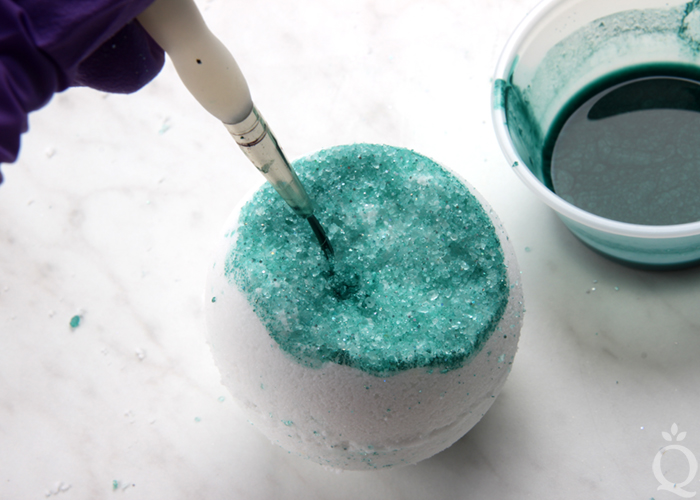 THIRTEEN: Use another paint brush to apply the white mica mixture to the highest points of the salt.
THIRTEEN: Use another paint brush to apply the white mica mixture to the highest points of the salt.
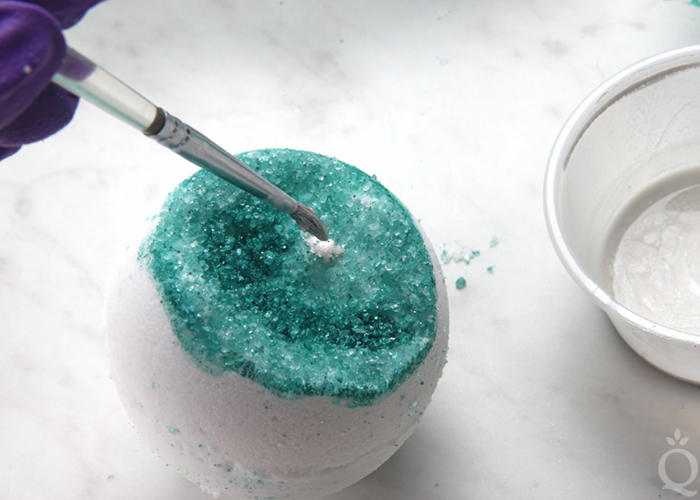
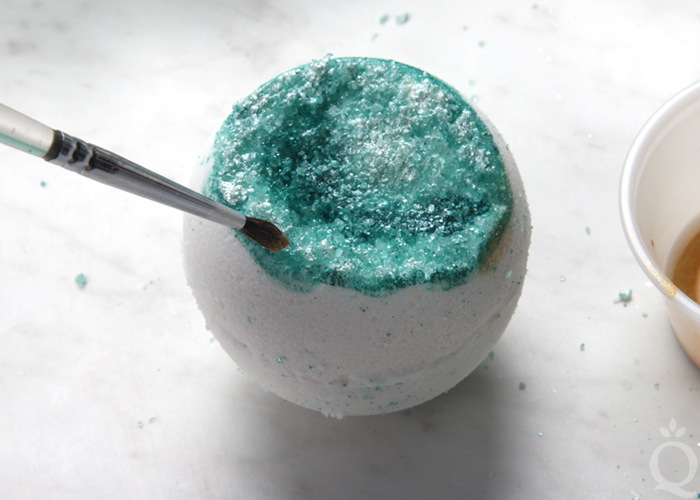 FOURTEEN: Apply the gold mica mixture to various points of the salt, and use a clean brush with alcohol to blend. A little white mica is also great for blending. Apply a thin line of gold mica to the outline of the salt for more definition. Remember, this is an art not a science. There is no right or wrong way to paint these bath bombs. The more you paint, the easier it gets.
FOURTEEN: Apply the gold mica mixture to various points of the salt, and use a clean brush with alcohol to blend. A little white mica is also great for blending. Apply a thin line of gold mica to the outline of the salt for more definition. Remember, this is an art not a science. There is no right or wrong way to paint these bath bombs. The more you paint, the easier it gets.
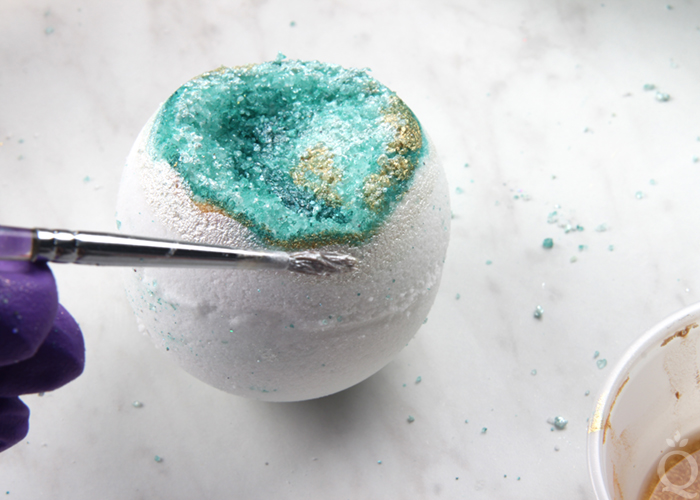 FIFTEEN: Apply very thin lines of the silver mica to the deep areas of the salt and around the edges. A little silver goes a long way, so apply sparingly.
FIFTEEN: Apply very thin lines of the silver mica to the deep areas of the salt and around the edges. A little silver goes a long way, so apply sparingly.
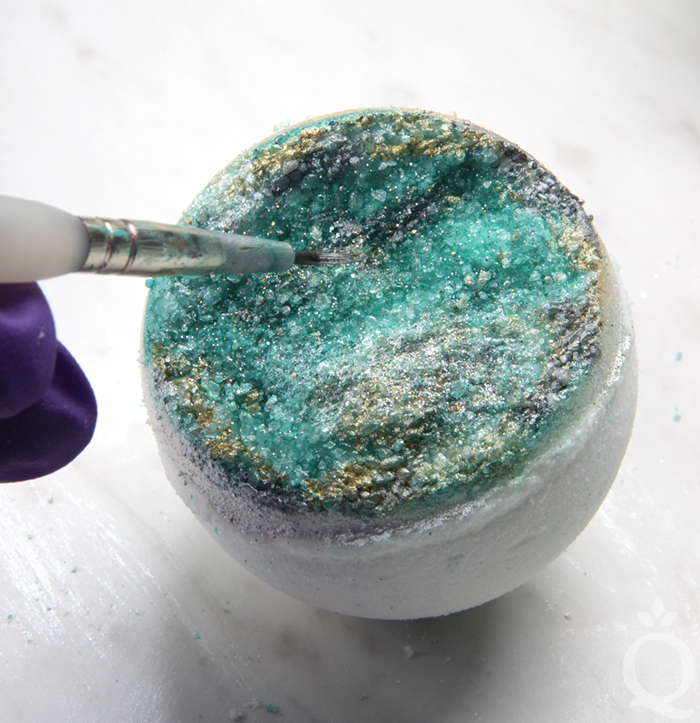 SIXTEEN: Spray the Fine Silver Rainbow EcoGlitter to the top of the salt for a sparkly finishing touch. Allow the mica paint to thoroughly dry.
SIXTEEN: Spray the Fine Silver Rainbow EcoGlitter to the top of the salt for a sparkly finishing touch. Allow the mica paint to thoroughly dry.
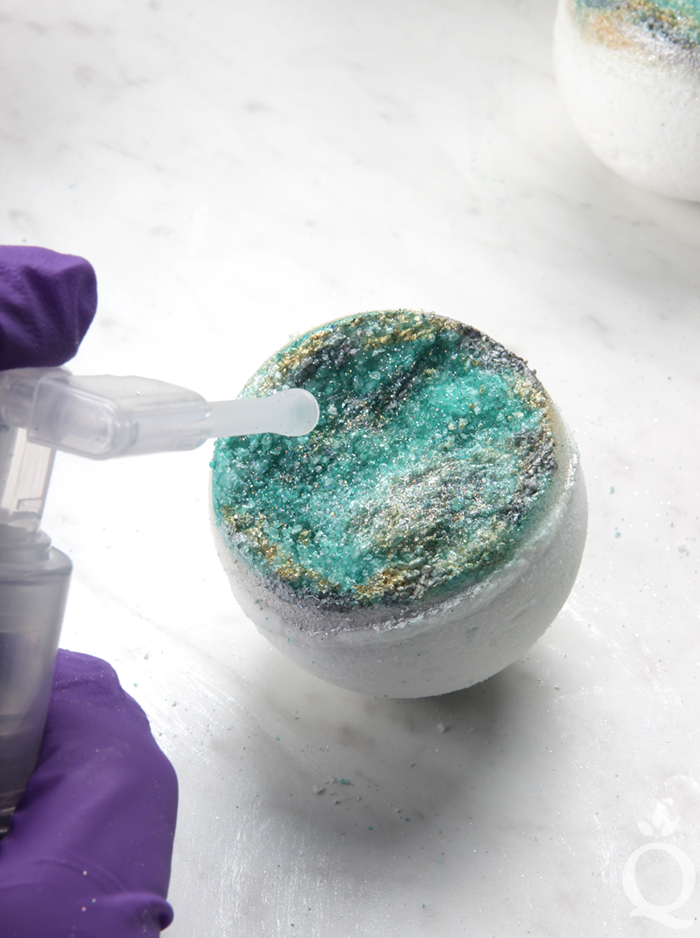
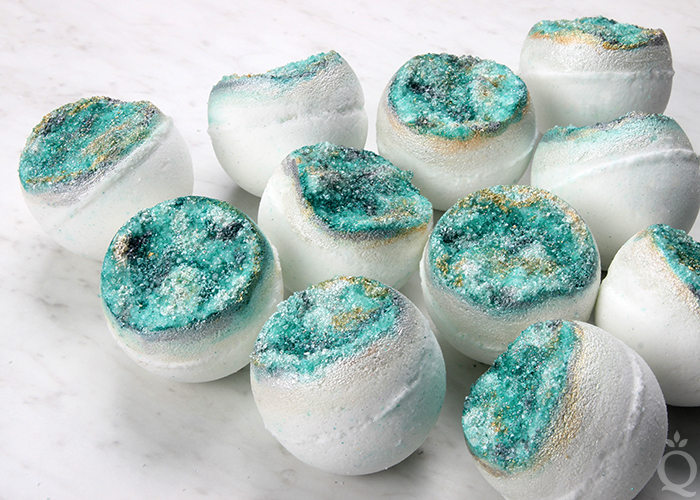
Once you’re ready to use, place the bath bomb into hot tub water and enjoy! These bath bombs are very delicate, so handle with care.
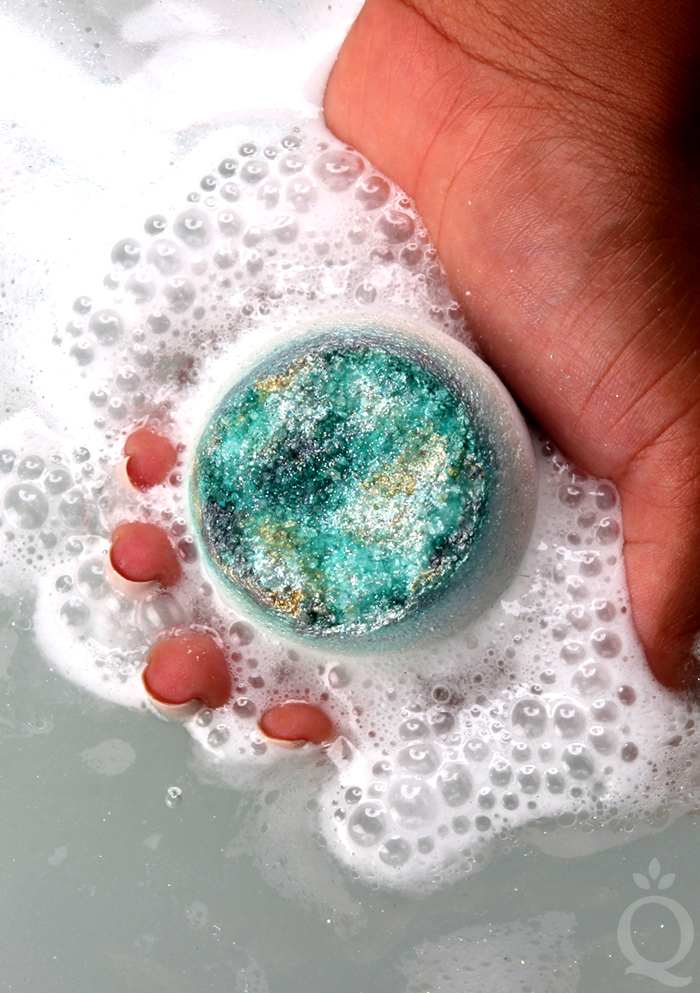
- 10 Bath Bomb Mold & Package
- 26 oz. Sodium Bicarbonate (Baking Soda)
- 13 oz. Citric Acid
- Witch Hazel in a Spray Bottle
- 0.7 oz. Jade Fragrance Oil
- 3 oz. Deodorized Cocoa Butter
- 0.6 oz. Polysorbate 80
- 6 oz. Fine Grained Dead Sea Salt
- Shamrock Green Mica
- Super Pearly White Mica
- Gold Sparkle Mica
- Pewter Silver Mica
- ½ tsp. Fine Silver Rainbow EcoGlitter
- Powder Sprayer (filled with Fine Silver Rainbow EcoGlitter)
- Melt the cocoa butter in a small heat-safe container in the microwave using 30-60 second bursts. Because cocoa butter has a high melting point, be very careful when removing the container from the microwave – it will be very hot.
- Add the polysorbate 80 and Jade Fragrance Oil to the melted cocoa butter. Stir to mix all the ingredients together.
- In a separate large container, mix together the baking soda and citric acid. To get rid of clumps in the mixture, you can push the powder through a sifter or break them up with your fingers. Citric acid has a tendency to take off nail polish, so wear gloves to protect your manicure. Thoroughly stir the ingredients together.
- Add the oil mixture to the baking soda and citric acid. Use gloved hands to thoroughly mix all the ingredients together. Set aside.
- In a separate bowl, add the fine grained Dead Sea salt, ½ tsp. Fine Silver Rainbow EcoGlitter, and ¼ tsp. Shamrock Green Mica. Use a spoon to mix all the ingredients together.
- Place some green salt into one half of the bath bomb mold. It should fill the mold about ⅓ of the way. Keep in mind that once the bath bomb is umolded, the salt will be dusted off the bath bomb to give the crystal shape. Don’t be afraid to use a deep layer of salt.
- Test the consistency of the bath bomb mixture. The perfect consistency for molding is similar to wet sand and holds its shape when squeezed. If it’s too dry, use one hand to spritz the mixture with witch hazel and one to mix. Continue spritzing until the mixture holds its shape when squeezed. Cover the salt with bath bomb mixture. Gently pack the bath bomb mixture into the mold, but leave some loose mixture on top.
- Fill the other half of the bath bomb mold with mixture, packing in gently and leaving some loose mixture on the top. Overfilling each half slightly with loose mixture helps the two halves stick together. Wipe away any mixture that got in the seams of the mold, match the eyelets of each side up, and press together. To avoid any imperfections on your bath bomb, make sure to direct pressure to the edges of the mold rather than the center.
- Continue filling up each bath bomb with the salt mixture and bath bomb mixture. Once the molds are all filled, allow the bath bombs to dry and harden in the molds. For the best results, we recommend leaving the bath bombs in the mold overnight. The longer they dry, the more durable they will be.
- Remove the bath bombs from the mold by pulling on both eyelets. Once unmolded, use your finger to gently brush away the extra salt. You’ll be left with a bath bomb with an indent.
- Remove all the bath bombs from the mold and remove the excess salt. If you like, you can save the salt for future projects. In separate containers, mix together ½ tsp. of Super Pearly White Mica, Shamrock Green Mica, Gold Sparkle Mica, and Pewter Silver Mica into about ½ Tbsp. of 99% isopropyl alcohol. The mica mixture should be thin but still saturated. As you paint, you’ll find your preference of mica paint texture. Add more mica or alcohol according to your preference throughout the painting process. Fill a small container with alcohol to rinse your brush and blend colors. Finally, fill the Powder Sprayer with Fine Silver Rainbow EcoGlitter.
- Starting with the Shamrock Green Mica, use a fine detail paint brush to apply the mica mixture to the deepest areas of the bath bombs. This gives them depth. Use the Shamrock Green Mica to also line the salt area of the bath bomb.
- Use another paint brush to apply the white mica mixture to the highest points of the salt
- Apply the gold mica mixture to various points of the salt, and use a clean brush with alcohol to blend. A little white mica is also great for blending. Apply a thin line of gold mica to the outline of the salt for more definition. Remember, this is an art not a science. There is no right or wrong way to paint these bath bombs. The more you paint, the easier it gets.
- Apply very thin lines of the silver mica to the deep areas of the salt and around the edges. A little silver goes a long way, so apply sparingly.
- Spray the Fine Silver Rainbow EcoGlitter to the top of the salt for a sparkly finishing touch. Allow the mica paint to thoroughly dry.
- Once you’re ready to use, place the bath bomb into hot tub water and enjoy! These bath bombs are very delicate, so handle with care.
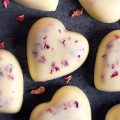

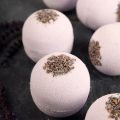
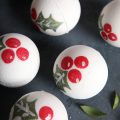
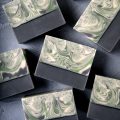
Thanks for letting us know. We have moved the blog to In The Studio so that should work more quickly for you.
Here is a link: https://www.brambleberry.com/in-the-studio
Hey there!
I can’t find polysorbate 80 and witch hazel in my country. Is there any alternative for these two? Is it possible to make bath bomb without using them.
Polysorbate 80 is pretty unique in what it does, but you can always use alcohol as a replacement for witch hazel, you just have to work quickly with it.
How can we label the ingredients on the finished product to sell? Is there a post about how to list ingredients?
Here’s a link to the FDA’s cosmetic labeling guide: https://www.fda.gov/cosmetics/labeling/regulations/ucm126444.htm
It is my understanding from discussions with FDA staff that glitters of any kind should not be used in bath bombs. They did not enforce it for years but have really started cracking down of late. Most Micas not all but most, are okay but never any type of glitter. Do you have documentation from FDA that differs from info given to me? If so, can you please share.
All of our colorants and glitters are cosmetic grade and safe for use on the skin or in soap. Recently there has been some confusion about which colors/glitters are safe for use in bath bombs. The FDA has a list of approved colorants (https://www.fda.gov/Cosmetics/Labeling/IngredientNames/ucm109084.htm), but whether colorants for bath bombs fall into the external use category is unclear. Because our colorants are skin safe and bath bombs are heavily diluted in water, we feel safe using them in our recipes.
If you plan to sell your products or if you want to be extra careful, you should avoid any colorants or glitters that fall in that gray area. This generally includes colorants with green oxide or ultramarines. Each description on the website will note whether the product contains external use only ingredients.
The other aspect to consider in deciding whether to use glitters is the environmental damage that occurs after they (and other microplastic particles) rinse off down the drain.
http://listverse.com/2018/08/20/top-10-strange-and-scary-facts-about-microplastics/
We also have a 100% biodegradable EcoGlitter.
https://www.brambleberry.com/Fine-Silver-Rainbow-EcoGlitter-P6739.aspx
https://www.brambleberry.com/Silver-Rainbow-EcoGlitter-P6738.aspx
Hi,
I would like to try to make these bath bombs but I use a press due to arthritis in my hands. I have found that many of the bath bomb recipes don’t always work with a press. Do you have any suggestions for modifying the recipe to be press friendly?
Thanks, Kim
What’s happening when you’re pressing the bath bombs? I can suggest a few ingredients that may help.
What kind of gloves do you recommend for making bath bombs? I made some and wore gloves, but my hands were sore afterward. Google said latex or vinyl gloves are recommended, but I used nitrile, which is the standard replacement for latex, so I was surprised my hands were so sore after.
We use nitrile gloves for bath bombs. I’m not sure why your hands were sore, you may try a different size or talk to your doctor about possible allergies.
This looks amazing! Are we able to see the finished product of other individuals?
People do post pictures on the #BrambleOn tag, you can see those here: https://www.instagram.com/explore/tags/brambleon/
I found a few pictures on the #CrystalBathBombs tag: https://www.instagram.com/explore/tags/crystalbathbombs/
I tried it and looks amazing,but the salt layer falls off the bathbomb 🙁
The salt will fall off the bath bomb as it’s not attached securely. When you unmold it, try to scrape off as much excess salt as possible. You can keep that in a jar to use later. Once your bath bombs are in the packaging, it will catch any salt that falls off and you can toss that in the tub when you’re ready to use it.
I found that removing the excess salt (that creates the negative space) with a soft bristle brush (think makeup brush) works perfectly. It gets rid of those pesky excess grains that can interfere with your mica painting.
Thanks for the great tips CC.
If I wanted to colour the bath bomb mixture would I just add mica into the dry mix of baking soda and citric acid, or the mixture of wet ingredients? Also, if I wanted to create some deeper grooves do you think incorporating larger salts like epsom salts with the salt used in this recipe would work?
Love this tutorial and can’t wait to try it out!
You can add color either way – I personally find it’s a bit easier to mix the color into the dry ingredients first before adding the wet ingredients.
Micas: https://www.brambleberry.com/Micas-C46.aspx
As for the larger salts, we didn’t give that a try but I think it would work just fine. You may want to try a test bath bomb first before making a full batch.
I’ve used a medium grain salt and it offered a bit more dimension to the surface than the fine grain.
What is the suggested retail price for each ?
It depends on a number of factors, including the time, labor, ingredients, and the market you’re in. This post talks more about how to price your products: https://www.soapqueen.com/business/much-charge-products/
Can I use a butter other than coco butter?
Yes, you can use another butter or another oil if you like. Shea or mango would feel nice in this recipe. They are softer than cocoa butter, so the bath bombs will have a different consistency. I would recommend making a small test batch with the substitution to see what you think.
Shea butter: https://www.brambleberry.com/Shea-Butter-P3220.aspx
Mango butter: https://www.brambleberry.com/Mango-Butter-P3221.aspx
Learn more about butters here: https://www.soapqueen.com/bath-and-body-tutorials/tips-and-tricks/all-about-butters-in-bath-beauty-products/
And this post has more tips on incorporating oil into bath bombs: https://www.soapqueen.com/bath-and-body-tutorials/bath-bomb-questions-answers/
What about using coconut oil?
Can I use Polysorbate 20 instead of 80?
Polysorbate 20 helps emulsify lighter fragrance oils, but it doesn’t work as well for the heavier cocoa butter. You can give it a try in this recipe, but for best results we recommend polysorbate 80.
Could I use a veg glycerin instead of the polysorbate ?
Glycerin won’t work the same way as the polysorbate. The polysorbate is an emulsifier that helps the color and oil mix into the bath water, while glycerin is a humectant that draws moisture to the skin. If you want the oil and color to mix into the water, you’ll need to use the polysorbate 80.
what´s the purpose of using polysorbate 80? hardener?
thanks
Polysorbate 80 is an emulsifier, which means it helps oil and water blend together. In this recipe, it helps the cocoa butter mix into the tub water. You can make bath bombs without it, but you will experience large pools of oil in the tub. The polysorbate 80 also helps prevent the mica from clinging to the side of the tub.
-Amanda with Bramble Berry
Hands down!, the most beautiful thing you all have created yet!!
Congratulations,
Laura
Thank you Laura!
-Kelsey with Bramble Berry
Wow…this is pretty cool. They will look like little Geode gems! The paint work, shimmer and crater will be a great selling feature!
Different and awesome!
Tanya
Thank you Tanya, hope you get a chance to give this technique a try. 🙂
-Kelsey with Bramble Berry